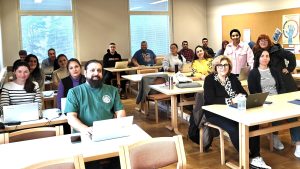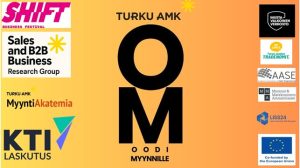-Haluan työskentelemään. En halua vastaanottaa toimeentulotukea Suomesta valtiolta. Näin kommentoi ulkomaalaistaustainen sosionomiopiskelija Omer, kun kysytään suunnitelmia valmistumisen jälkeen. Mediasta…
Tekijät | Authors
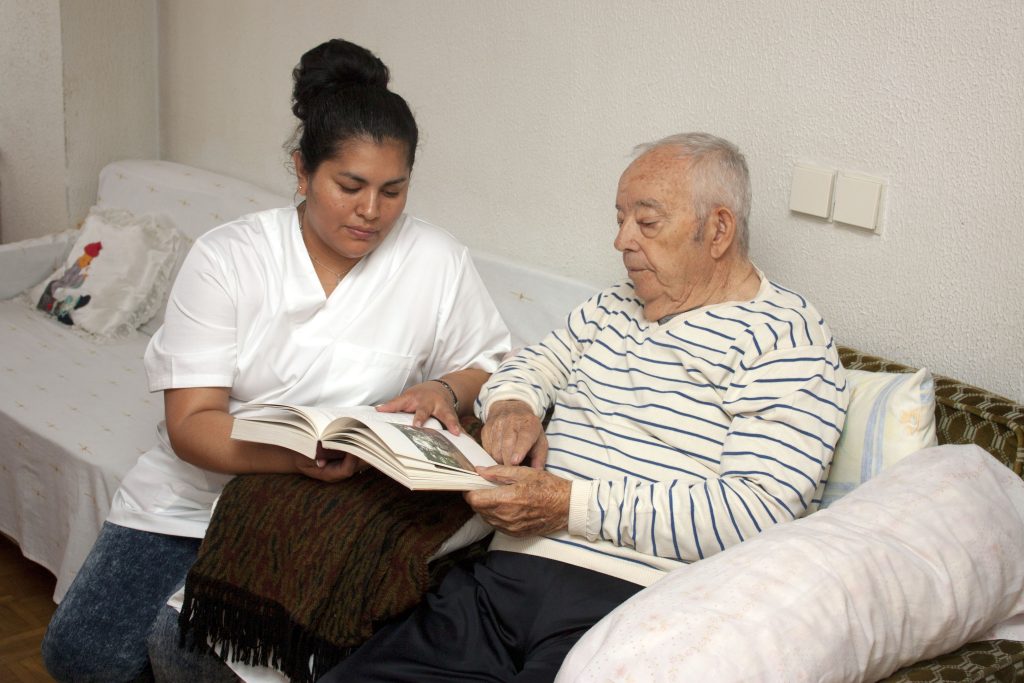
Cultural competence can be taught with effective methods in nursing education
The increasing diversity in Europe challenges nursing education to train nurses that are culturally competent to work with varied people groups anywhere in the world. We made an extensive literature review to identify successful ways to train nurses with the required competencies.
Initially, cultural competence focused on immigrant populations, but it expanded to include nonimmigrant minority groups (Saha et al., 2008). The scope also broadened to address factors like prejudice, stereotyping, gender, sexuality, racism, bias, (mis)trust, power, privilege, and status (Jongen et al., 2018; Saha et al., 2008). In this respect, the concept of diversity sensitivity is increasingly used (Europe, 2020, p. 9).
Generally considered, cultural competence in health care is the ability to improve the health and wellbeing of patients from different cultural backgrounds (Yadollahi et al., 2020). There are many definitions and models of cultural competence (Saha et al., 2008; Shen, 2015).
One of the most well-known definitions by Campinha-Bacote (2002, p. 181) portrays cultural competence in nursing to be a continuous process of gaining abilities to effectively work within the cultural context. This process involves the integration of cultural awareness, cultural knowledge, cultural skill, cultural encounters, and cultural desire.
Effective ways to promote cultural competence in nurses and nursing students
Evidence shows that cultural competence can be developed through training. Our review and previous ones (De-María et al. 2024; Gallagher & Polanin 2015; Oikarainen et al. 2019) show the use of varying teaching methods. Based on our literature review methods for teaching cultural competence were grouped into classroom teaching, online teaching, simulation and cultural immersion (Figure 1.). All these methods were beneficial in increasing cultural competence of nurses and nursing students.
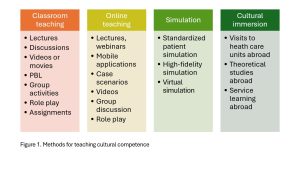
Traditional classroom methods like lectures, discussions, reflections, and role-plays have been used for decades (De-María et al. 2024; Gallagher & Polanin 2015; Oikarainen et al. 2019). Recently, the use of online and web-based methods has increased, with one-third of studies in our review applying these methods, more than reported in the review by De-María et al. (2024). The systematic review by Gallagher & Polanin (2015) neither reported web-based learning or online learning, apps, nor virtual simulations, indicating their recent development.
Simulation has received special attention in teaching cultural competence. Simulation has been used for years (Gallagher & Polanin 2015; Oikarainen et al.2019; Silén-Lipponen & Aura 2021) and can enhance cultural knowledge, communication skills, nursing skills, self-awareness, and self-efficacy (Silén-Lipponen & Aura 2021). Also, our review shows that cultural competence can be increased through simulation (Shin et al. 2023).
Cultural immersion abroad has been a voluntary way of learning for decades. This method also increased participants’ cultural competence. The experience abroad increased student’s confidence in working with diverse patients. (Long 2014.)
Other aspects that should be considered in teaching cultural competence
Cultural competence can be enhanced through various educational methods. It is not recommended to use a single method but rather a combination to cover all dimensions of cultural competence.
The first step in planning is to analyze the need for cultural competence education and set learning goals. Selecting a theoretical framework or model will guide the course design and content. Involving professional experts and representatives of minority groups or people from different cultural backgrounds in developing the training is recommended.
The duration of educational interventions varies, with both longer and shorter interventions improving cultural competence. Short interventions can develop cultural knowledge, but changes in attitudes and skills seems to take longer (Majda et al., 2021). Learning both cognitive and behavioral skills takes time, so the duration of the education should be planned to meet the learning goals.
Given the different dimensions of cultural competence, using diverse teaching methods is recommended. Different methods require different equipment and resources. For example, online learning needs both hardware and software, as well as IT skills from both organizers and participants. Simulation works best when students have prior education through other methods. After implementing training programs, they should be evaluated based on student learning outcomes and experiences.

The research leading to these results has been funded with support from the European Commission (Project nr: 101128620). This publication reflects the views only of the authors, and the Commission cannot be held responsible.
References
Campinha-Bacote, J. 2002. The Process of Cultural Competence in the Delivery of Healthcare Services: A Model of Care. Journal of Transcultural Nursing: Official Journal of the Transcultural Nursing Society, 13(3), 181–184; discussion 200-201. https://doi.org/10.1177/10459602013003003
De-María, B., Topa, G., & López-González, M. A. 2024. Cultural Competence Interventions in European Healthcare: A Scoping Review. Healthcare, 12(10), Article 10. https://doi.org/10.3390/healthcare12101040
Europe, W. H. O. R. O. for. 2020. Migration and health: Enhancing intercultural competence and diversity sensitivity. World Health Organization. Regional Office for Europe. https://iris.who.int/handle/10665/332186
Gallagher, R. W., & Polanin, J. R. 2015. A meta-analysis of educational interventions designed to enhance cultural competence in professional nurses and nursing students. Nurse Education Today, 35(2), 333–340. https://doi.org/10.1016/j.nedt.2014.10.021
Jongen, C., McCalman, J., & Bainbridge, R. 2018. Health workforce cultural competency interventions: A systematic scoping review. BMC Health Services Research, 18(1), 232. https://doi.org/10.1186/s12913-018-3001-5
Long, T. 2014. Influence of international service-learning on nursing student self-efficacy toward cultural competence. The Journal of Nursing Education, 53(8), 474–478. https://doi.org/10.3928/01484834-20140725-02
Majda, A., Zalewska-Puchała, J., Bodys-Cupak, I., Kurowska, A., & Barzykowski, K. 2021. Evaluating the Effectiveness of Cultural Education Training: Cultural Competence and Cultural Intelligence Development among Nursing Students. International Journal of Environmental Research and Public Health, 18(8). https://doi.org/10.3390/ijerph18084002
Oikarainen, A., Mikkonen, K., Kenny, A., Tomietto, M., Tuomikoski, A.-M., Meriläinen, M., Miettunen, J., & Kääriäinen, M. 2019. Educational interventions designed to develop nurses’ cultural competence: A systematic review. International Journal of Nursing Studies 98, 75–86. https://doi.org/10.1016/j.ijnurstu.2019.06.005
Saha, S., Beach, M. C., & Cooper, L. A. 2008. Patient Centeredness, Cultural Competence and Healthcare Quality. Journal of the National Medical Association, 100(11), 1275–1285. https://doi.org/10.1016/S0027-9684(15)31505-4
Shen, Z. 2015. Cultural Competence Models and Cultural Competence Assessment Instruments in Nursing: A Literature Review. Journal of Transcultural Nursing, 26(3), 308–321. https://doi.org/10.1177/1043659614524790
Shin, M., Na, H., & Kim, S. 2023. Enhancing cultural competency and empathy toward foreign patients for Korean nursing students through a simulation: A quasi-experimental study. Nurse Education in Practice, 69, 103615. https://doi.org/10.1016/j.nepr.2023.103615
Silén-Lipponen, M., & Aura, S. 2021. Cultural competence learning of the health care students using simulation pedagogy: An integrative review. Nurse Education in Practice, 52, N.PAG-N.PAG. CINAHL Complete. https://doi.org/10.1016/j.nepr.2021.103044
Yadollahi, S., Ebadi, A., & Asadizaker, M. 2020. Measuring Cultural Competence in Nursing: A Review Study. Journal of Client-Centered Nursing Care, 6(3), 203–212. https://doi.org/10.32598/JCCNC.6.3.338.1
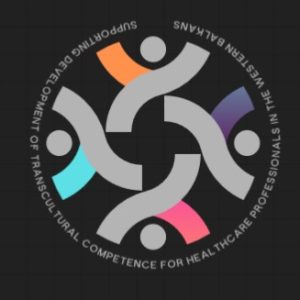

TCCWB – Supporting Development of TransCultural Competence for Healthcare Professionals in the Western Balkans
Duration of the project: 1.4.2024.–31.3.2027
Aim of the project is to develop a new study program focused on transcultural competence in nursing for beneficiary HEIs in Albania and Bosnia and Herzegovina.
The original literature review will be published on EU platform
This publication is part of work of Turku UAS research group Developing Better Health Care in Hybrid World.







